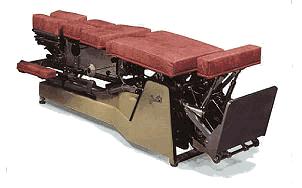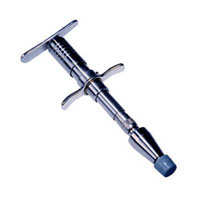
Chiropractors use a myriad of
techniques
often named after the college they attended or a person that developed
the particular method of adjusting your body. Below we have attempted
to
compile a brief description of common chiropractic techniques that are
used in our clinic:
 |
The THOMPSON TECHNIQUE, pioneered by Dr. J. Clay Thompson, is both a system of analysis and adjustive procedures, utilizing a drop assisted table. |
The basic Thompson Analysis and
Adjusting
Technique is known for its specific
categories which help the doctor
identify
the subluxations and whether the primary problem is in the cervical or
the lumbo-sacral region. The categories also tell the doctor the order
in which each adjustment will be rendered and which end to adjust first.
The greatest single difference between other chiropractic adjusting tables and the Thompson Terminal Point Table is that each cushion will singly, or in combination, drop one-half inch. The "Segmental Drop System" takes advantage of the spines inherent design of the joints in order to move the spinal segment in the direction that will improve the motion of the segment with the one above and below. It just makes good sense that since the spinal joints face front to back and have an incline that slopes more naturally backwards that we can effect increased motion by applying an adjustment from P to A, (Posterior to Anterior) and with an inferior to superior line of correction.
The spinal adjustment is given when the
cushion reaches the bottom of its drop (the terminal point of its
drop). The patient's body is unable to react fast enough to
resist the adjustive thrust. Since there is no muscular
resistance, very little force is used, the adjustment is more effective
and the pain and physical strain to both the patient and doctor is
eliminated. Greater effectiveness is the result!
The majority of the spinal adjusting
utilizing
the Thompson Technique has the patient lying prone. (face down.) This
is
the basis for Dr. Clay Thompson’s theory of proper spinal adjusting and
the driving force that lead him to invent the drop table.
| Why does my chiropractor keep
looking
at my feet?
The Derifield-Thompson test for
leg length
inequality (LLI) is a specific body
tone analysis commonly used by
chiropractors
to assess a need for adjustment, determine the site and state of
Subluxation,
the hand contact for correction, and to evaluate the results of the
adjustment. An imbalance
in the length of the legs is observed when the patient is in a prone
(face down) position on the table. The "Leg Length System" is based on
the early
work of Dr. Derifield of Detroit, Michigan. The neurological basis for
balance is found in the Reticular System of the brain where the
Inhibitory and Facilitory systems maintain balance of the musculature
of the body. When the spine is in
balance and free of nerve interference, the patient's legs are even,
the hips are level, and the neck Subluxation
levels are based on the "Leg Analysis "to determine what areas that may
need to be adjusted. This is correlated with Physical Examination,
X-ray and Motion findings, Palpation and Instrumentation utilized by
the Doctor of Chiropractic. Examples of Subluxation pattern
findings with The Derifield Leg Check System which would indicate the
need for a spinal adjustment: Cervical syndrome: turning the head in the prone position balances leg lengths that appeared uneven, or unbalances leg lengths that appeared even. Pelvic negative syndrome (D-): a knees-extended apparent short leg remains short when the knees are flexed. Pelvic positive syndrome (D+): a
knees-extended apparent short leg appears longer when the knees are
flexed Analyzing and adjusting a patient on the Thompson Table is like turning pages in a book. As each subluxation is identified and corrected, like turning a page, it reveals something different, another subluxation in a different part of the spine. When this is corrected, it reveals another and so on, until all present subluxations have been cleared. When all the criteria are met, no adjustment is further given |
OTHER Techniques that may be used…
 |
ACTIVATOR - The chiropractor uses an instrument called an Activator to make your adjustment. It is a small hand held percussion-type tool in which a quick snap is applied to correct a vertebral misalignment according to a set pattern. This may most often be used when adjusting children or seniors. |
 |
TOGGLE RECOIL - A specific technique for the adjustment of the upper cervical spine (Primarily at C1). This technique usually utilizes a side posture table with a cervical head piece which makes a slight drop when the adjustment is given. |
GONSTEAD - A specific method for full spine adjusting utilizing the use of full spine x-rays to locate spinal misalignments and to determine the correct line of drive for the correction.
TRIGGER POINT THERAPY - This is
a
muscle
technique which utilizes deep pressure at certain locations in the
musculoskeletal
system where nodules or spasms have developed; this technique will
cause
relaxation of the muscle.